Blueprint
Brand tones
Your brand voice is one of your company’s most powerful assets. But keeping it consistent everywhere, every day? That’s a challenge—especially at scale. This blueprint walks you through how to define your brand voice and deliver it consistently across teams, tools, and customer touchpoints with Grammarly’s brand tones feature.
Develop | Deploy
Want to go even further? Add style rules to enforce brand-specific terminology and writing standards at scale.
Develop | Deploy
Want to go even further? Add style rules to enforce brand-specific terminology and writing standards at scale.
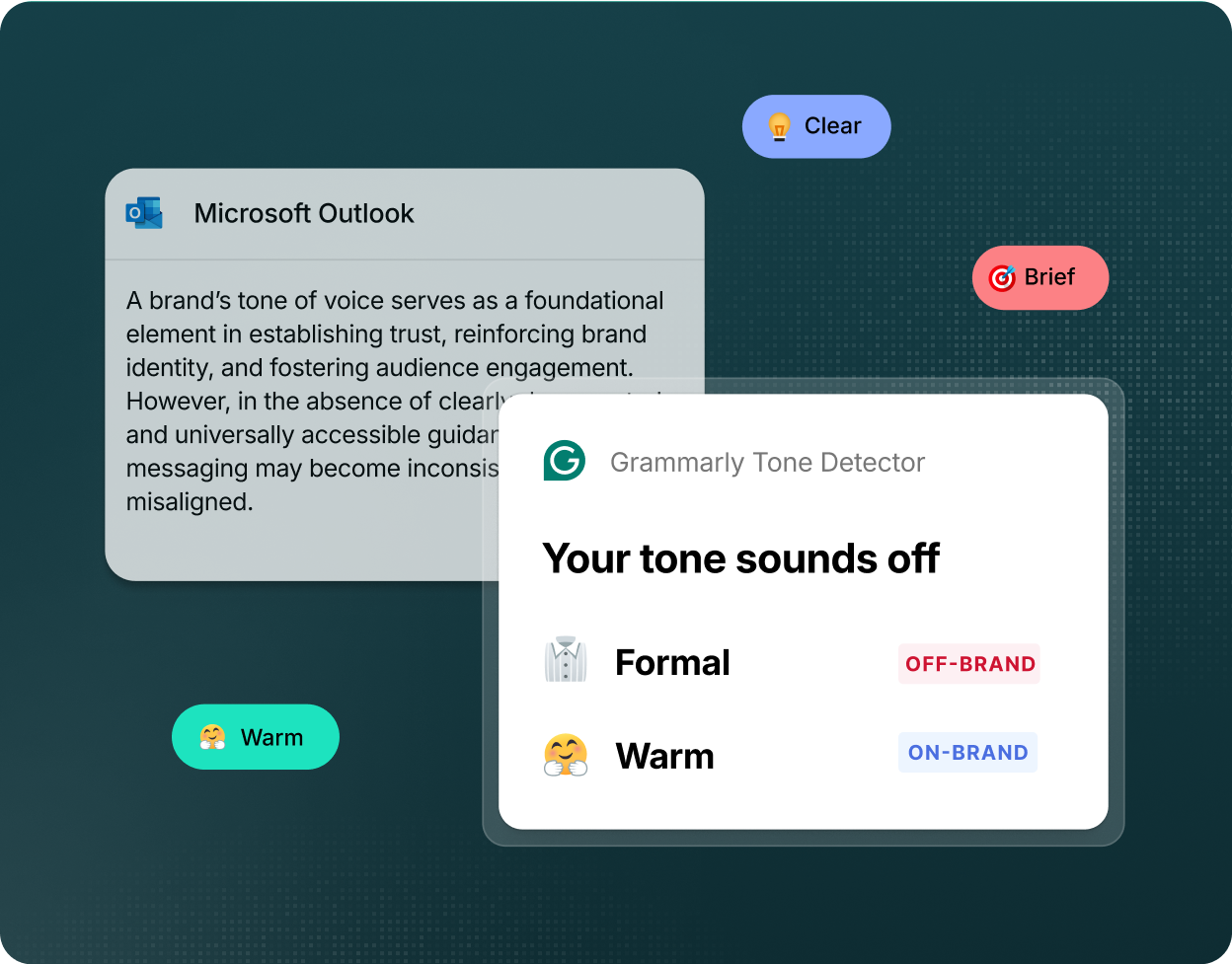
What you need
- One or two workshops or alignment sessions to define your brand voice and attributes
- A documented tone guide with definitions, dos and don’ts, and real examples
- 15–30 minutes to set up brand tones in Grammarly
Who to work with
- Marketing, communications, and brand representatives to inform and approve brand standards
- Writers, editors, and content creators from different teams to offer insight into how tone plays out in day-to-day content
- Grammarly admin to set up and manage brand tones in the platform
Why it matters
- Your brand tone distinguishes your company from its competitors.
- It brings your content to life in ways that build customer trust, strengthen brand affinity, and deepen connection.
- Without clear guidance that is readily available to every team wherever they work, a brand can quickly become inconsistent, unrecognizable, and even offensive.
How to develop your brand tone internally
Let’s walk through how to define your voice, shape your tone profile, align your team, and ensure every marketing message accurately represents your brand.
1. Identify and engage stakeholders.
Before you define your tone traits, get the right people involved. This ensures your tone profile is comprehensive, accurate, and more likely to gain buy-in and approval when it’s time to launch.
You’ll want to include:
Before you define your tone traits, get the right people involved. This ensures your tone profile is comprehensive, accurate, and more likely to gain buy-in and approval when it’s time to launch.
You’ll want to include:
- Brand, content, and communication leads
- Writers and editors from different teams (marketing, support, product)
- Leaders from product, comms, or executive teams who shape your company’s public voice
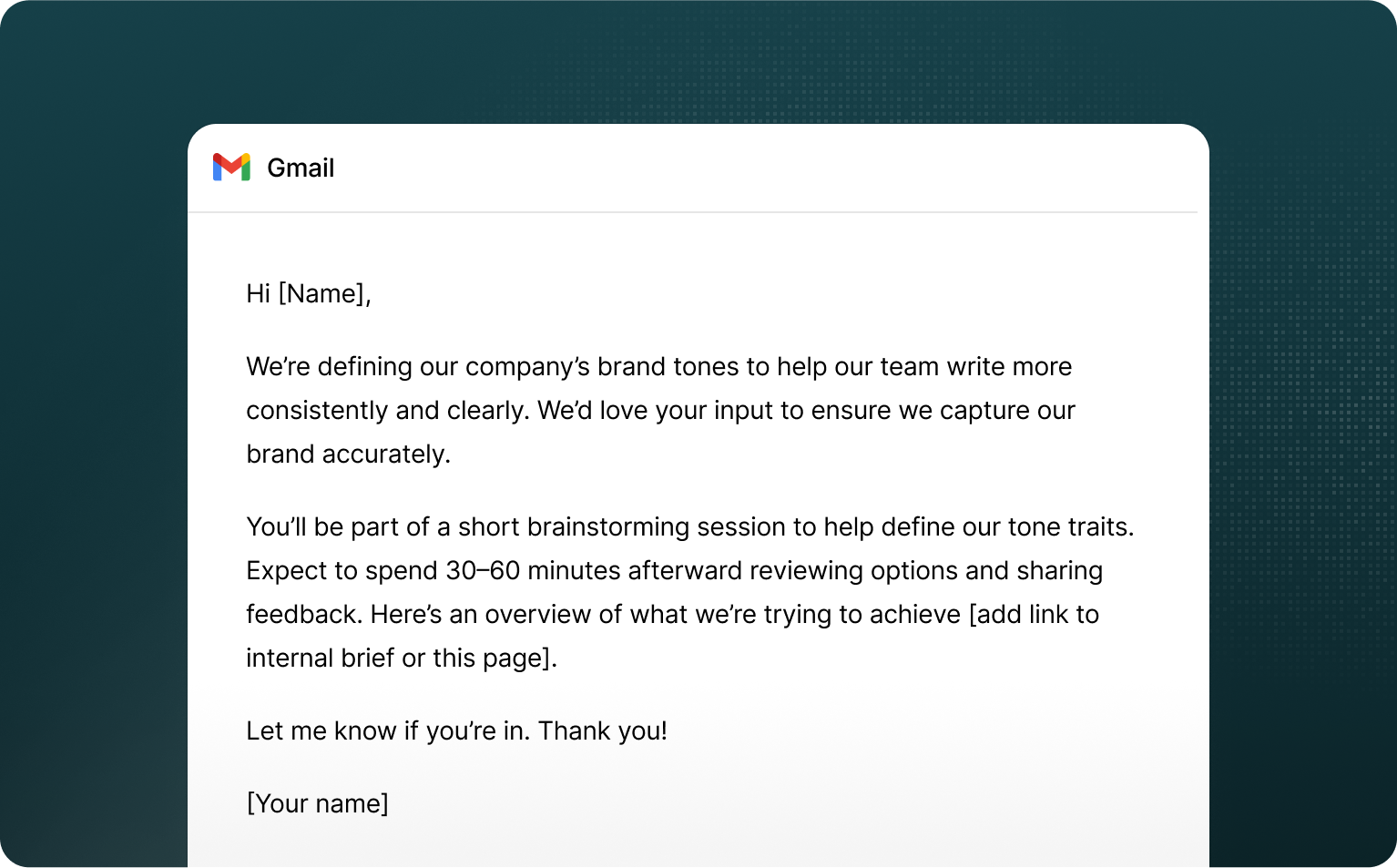
2. Define your brand’s tone.
This is the big step, and it works best as a structured, collaborative brainstorming meeting.
Before the meeting:
This is the big step, and it works best as a structured, collaborative brainstorming meeting.
Before the meeting:
- Share Grammarly’s tone list with your stakeholders.
- Ask each person to choose two to three tone traits that best reflect how they believe your brand should and should not sound.
- Encourage them to come prepared to explain their choices.
- Create a comfortable environment where people can share their recommendations openly.
- Capture and discuss each proposed tone.
- Identify overlaps or tensions between traits.
- Have the group vote to narrow it down to three to five core tones that represent your brand’s personality.
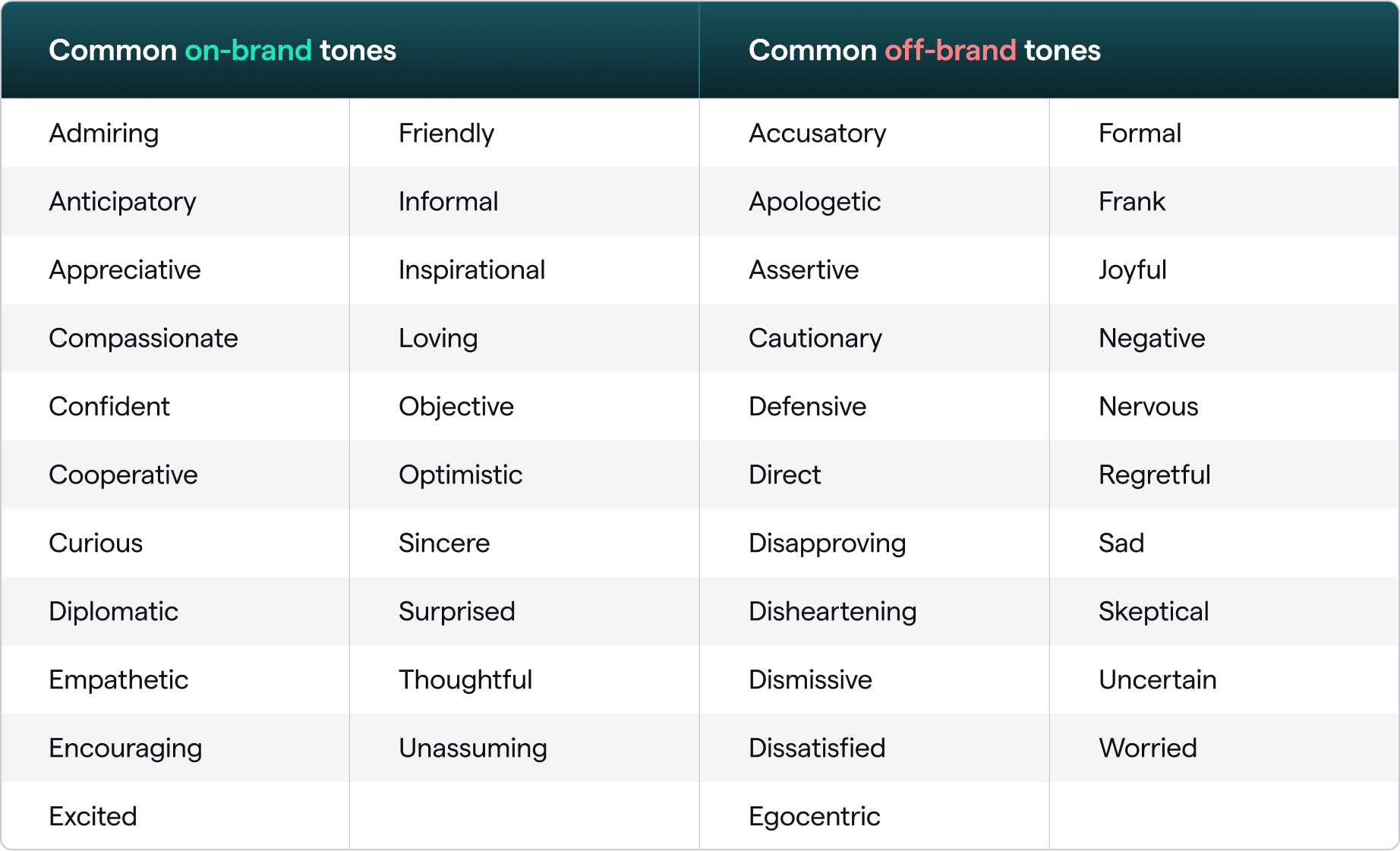
3. Hone your tone across channels.
Your brand isn’t one-dimensional—and your tone shouldn’t be either. Hone each tone trait to flex across different channels and audiences without losing its identity. You can then set multiple tone profiles and assign them to different groups based on where they write and who they talk to.
This is where you can get specific so that your team knows what tone to take across different channels or with different audiences. You’ll be able to provide explanations that help coach teammates in real time as they write.
Your brand isn’t one-dimensional—and your tone shouldn’t be either. Hone each tone trait to flex across different channels and audiences without losing its identity. You can then set multiple tone profiles and assign them to different groups based on where they write and who they talk to.
This is where you can get specific so that your team knows what tone to take across different channels or with different audiences. You’ll be able to provide explanations that help coach teammates in real time as they write.
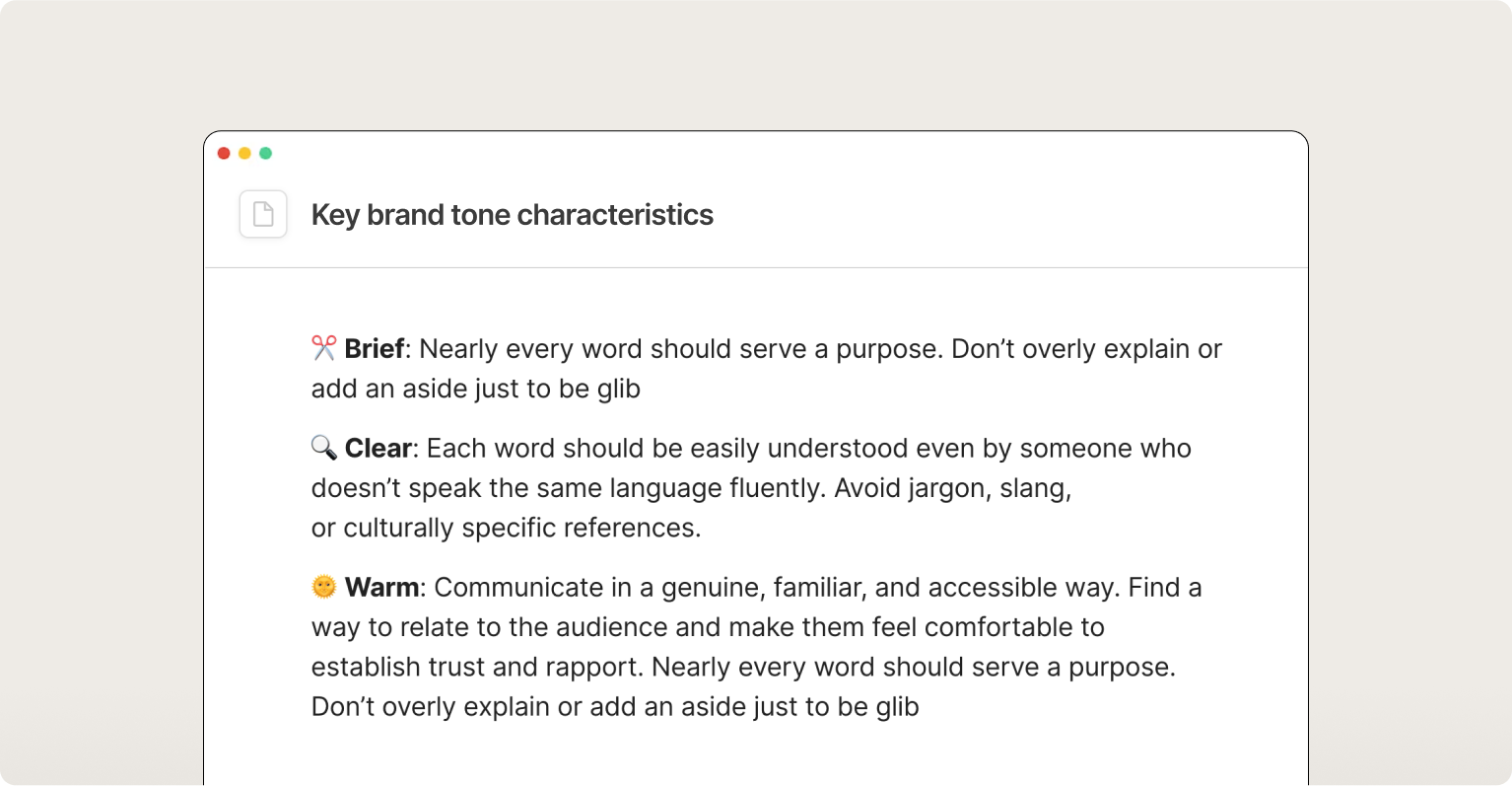
4. Create a shortlist of what good (and bad) looks like.
Once your tone traits are defined, bring them to life with real content examples. Collect internal content that does and doesn’t reflect your desired tone. This makes your tone profile more actionable for both your team and Grammarly.
Pull from a range of channels—landing pages, product updates, help docs, social posts. Flag standout examples to show what great looks like and call out off-brand moments to avoid.
Once your tone traits are defined, bring them to life with real content examples. Collect internal content that does and doesn’t reflect your desired tone. This makes your tone profile more actionable for both your team and Grammarly.
Pull from a range of channels—landing pages, product updates, help docs, social posts. Flag standout examples to show what great looks like and call out off-brand moments to avoid.
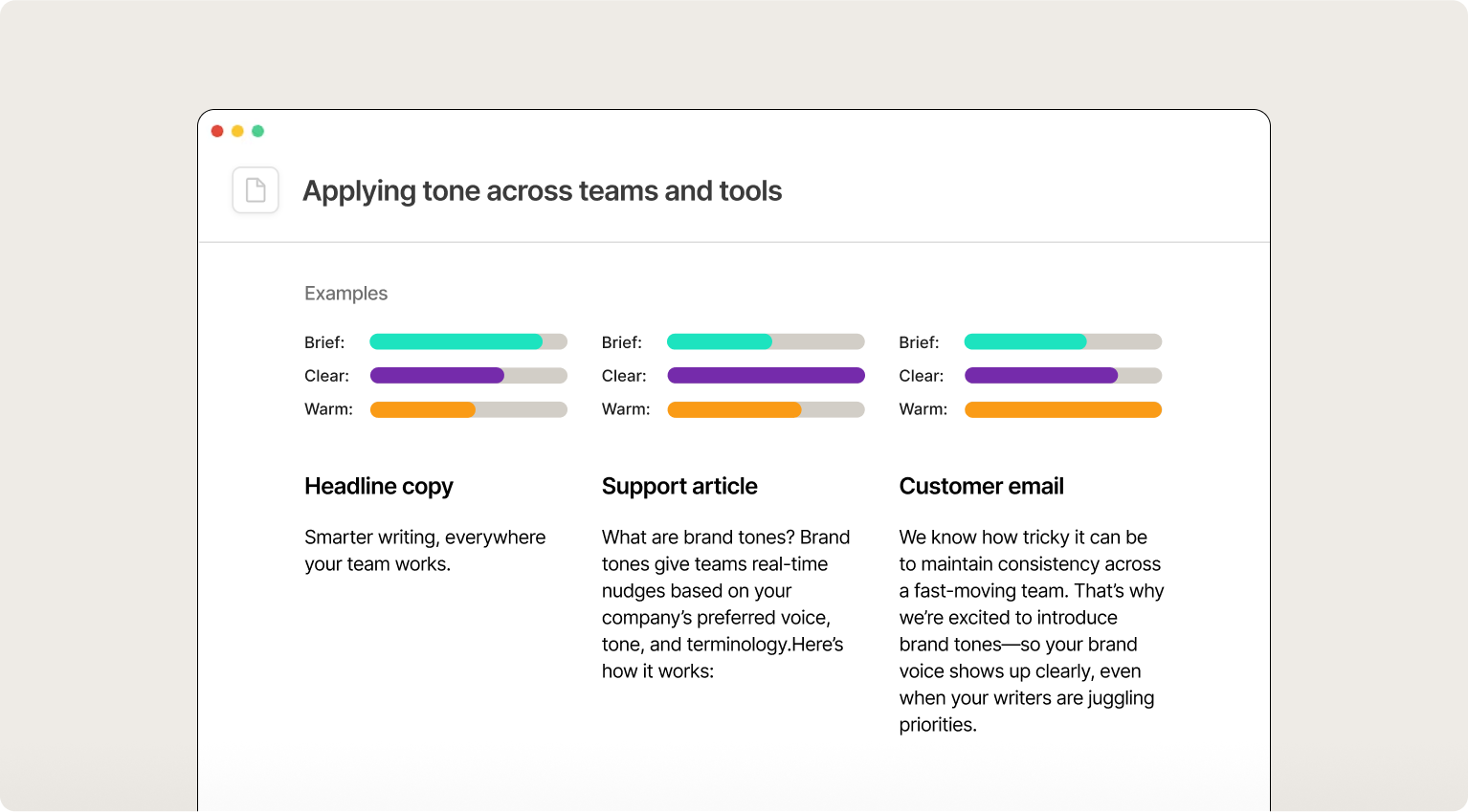
5. Document your guidelines and get approval from stakeholders.
Turn your tone decisions into a clear, shareable reference for your team. This guide should include:
Turn your tone decisions into a clear, shareable reference for your team. This guide should include:
- Your core tone traits and what they mean
- Dos and don’ts for each trait
- Real examples of on- and off-brand tones
- When and how to flex tone by audience or channel
Deploying brand tones in Grammarly
Whether your brand is casual and friendly or polished and professional, Grammarly helps reinforce that voice—everywhere your team writes.With Grammarly’s brand tones feature, you can designate brand tones that guide your team to strike the right note in every message.
How to set up a brand tone profile in Grammarly
1. Go to "Brand tones" in the admin panel.
To get started, head to your account hub. Click the Writing tab and select Brand tones.
2. Add your tone traits.
Next, you’ll set up your tone profile. This is where you’ll input the information from the steps above. Enter each tone with a clear definition. You can also include examples of what “good” and “off” tones look like to guide suggestions.
3. Save and share.
Once your brand tones are saved, these tones will instantly start informing your team’s writing. Grammarly will surface real-time tone suggestions to help writers align with your brand voice, no matter the tool or touchpoint.
4. Refine as you go.
You can fine-tune tones further by searching for, adding, or removing tones—so they stay up to date and reflect exactly how you want your team to sound across different channels.
Set the tone for your entire team
Bring your tone guide to life with Grammarly. Set up brand tones in less than a day to help your team write with clarity, confidence, and consistency—everywhere they work. Contact our team to get started.